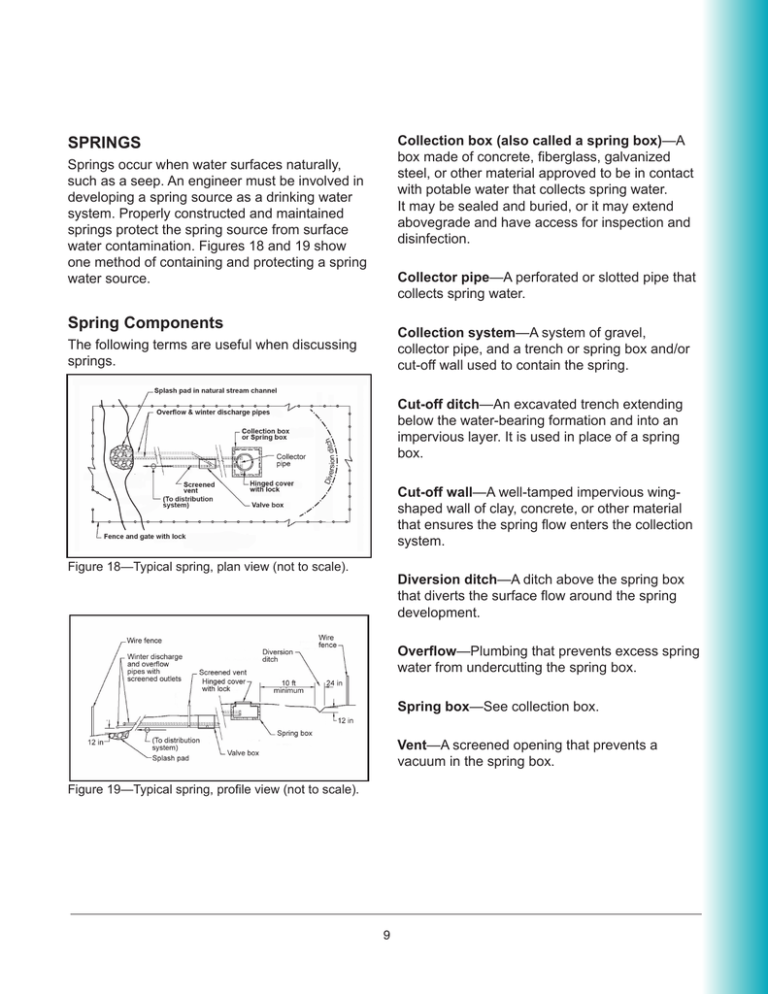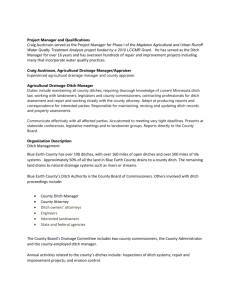SPRINGS
advertisement

Collection box (also called a spring box)—A box made of concrete, fiberglass, galvanized steel, or other material approved to be in contact with potable water that collects spring water. It may be sealed and buried, or it may extend abovegrade and have access for inspection and disinfection. SPRINGS Springs occur when water surfaces naturally, such as a seep. An engineer must be involved in developing a spring source as a drinking water system. Properly constructed and maintained springs protect the spring source from surface water contamination. Figures 18 and 19 show one method of containing and protecting a spring water source. Collector pipe—A perforated or slotted pipe that collects spring water. Spring Components Collection system—A system of gravel, collector pipe, and a trench or spring box and/or cut-off wall used to contain the spring. The following terms are useful when discussing springs. Cut-off ditch—An excavated trench extending below the water-bearing formation and into an impervious layer. It is used in place of a spring box. Cut-off wall—A well-tamped impervious wingshaped wall of clay, concrete, or other material that ensures the spring flow enters the collection system. Figure 18—Typical spring, plan view (not to scale). Diversion ditch—A ditch above the spring box that diverts the surface flow around the spring development. Overflow—Plumbing that prevents excess spring water from undercutting the spring box. Spring box—See collection box. Vent—A screened opening that prevents a vacuum in the spring box. Figure 19—Typical spring, profile view (not to scale). 9 Operation and Maintenance • Remove all dead vegetation within 25 feet of the spring (figure 20). Figure 20—Clear brush and grade to drain. • Remove woody brush and shrubs to prevent roots from intruding into the collection area. Figure 22—Repair damaged fencing. • Check that the spring box lid is locked (figure 23). The lid should be a shoe-box design with a 3-inch overhang. • Grade the spring collection area to prevent standing surface water. • Check that the fencing is intact and the gate is locked (figures 21 and 22). Figure 23—Spring box lid must be locked. • Check that the spring overflow is armored. Place a large rock in the overflow splash zone if it is missing (figure 24). Figure 21—Spring collection area should be fenced and locked. 10 • Check that the vent is screened and in good repair (figure 26). Figure 24—This overflow splash zone is armored. The screen must be repaired. • Check the overflow screen to ensure that it is intact. Replace damaged screen (figure 25). The screen mesh size may be specified by the State. Figure 26—This vent must be repaired. • Clean the diversion ditch of any winter debris (figure 27). Check that the ditch is in good repair and directs surface water around the spring collection area. Figure 25—Replacing screen. Figure 27—Diversion ditch. 11 Water Collection and Storage System • Check for and repair any obvious damage to the water collection and storage system (figure 28). Clean debris out of the spring box and repair the seals (figure 29). Figure 28—Check for damage to the spring’s water collection and storage system. Figure 29—Clean debris from the spring box and repair the lid seal. 12






